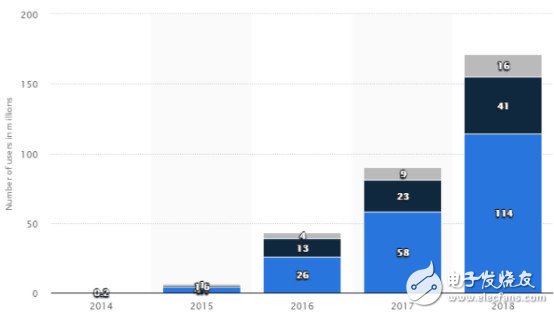Recently, a well-known foreign tech publication, The Next Web, released its forecast on the five major trends that will shape virtual reality (VR) technology in 2018. This report highlights how VR is moving from a niche market to a more mainstream and widely adopted technology. Looking back at the growth of the VR industry over the past few years, it's clear that we're witnessing a significant turning point. In 2014, there were only about 200,000 active VR users worldwide. By 2017, that number had jumped to 90 million, and by 2018, it's expected to reach 170 million—nearly doubling the previous year’s total. This exponential growth suggests that VR is no longer just a futuristic concept but a rapidly evolving field with real-world applications. As shown in the chart below, the VR industry has seen massive expansion in both user base and market value. The software sector alone grew from $129 million in 2015 to an impressive $2.57 billion by 2018. Furthermore, the entire VR industry is projected to generate $5.2 billion in revenue by 2018, with estimates reaching $45 billion by 2025. This represents a staggering increase from just $90 million in 2014, highlighting the explosive potential of this technology. With such rapid development, it's natural to ask: What are the key trends driving this transformation? Let’s explore the five main developments predicted for 2018. 1. **More 360-Degree Virtual Reality Videos**
According to research by Omnivirt, 360-degree videos have become increasingly popular compared to traditional video content. Their analysis of over 1,000 events showed higher engagement in terms of completion rates, clicks, and overall participation. These videos are not only spreading across different industries but also improving in quality and variety. Companies like NASA, Microsoft, IBM, Honda, and Ford have already started using 360-degree VR content. Even YouTube now has nearly 3 million subscribers for its 360-degree video channel. We can expect this format to become even more widespread in the coming years. 2. **More Augmented Reality (AR) Applications in Advertising**
The advertising industry is emerging as a strong driver for VR adoption. Last year, Google introduced VR-based ads, while Infiniti and Omnivirt partnered to offer a 360-degree car test drive experience. Chick-fil-A also launched interactive VR content. These examples show that AR and VR are becoming powerful tools for brands to engage with consumers. In 2018, we can anticipate even more creative and immersive ad campaigns that leverage these technologies. 3. **Rise of VR Developers**
As the VR industry expands, the demand for skilled developers is increasing. While VR game development has been ongoing, the need for more creators who can build immersive experiences is growing. Tech giants like Google are stepping in to support developers by offering financial incentives and tools to help them create high-quality VR content. This investment in talent will be crucial for sustaining the industry's growth. 4. **More Immersive Experiences**
One of the biggest goals in VR development is to enhance realism and immersion. Recent innovations, such as HEAR360’s 360-degree audio system, allow users to experience sound from all directions, making the virtual environment feel more lifelike. Some predictions even suggest that future VR systems could simulate smell and touch, bringing users closer to real-life sensations. These advancements will make VR more engaging and practical for everyday use. 5. **Lower Costs and Improved Usability**
In 2017, companies like Oculus and HTC began reducing prices, lowering their VR headset bundles by $200. This trend is expected to continue in 2018, making VR more accessible to the average consumer. Currently, most VR devices are still considered premium products, often costing thousands of dollars. However, as prices drop and usability improves, VR is likely to become a household technology rather than a luxury. Overall, 2018 looks set to be a pivotal year for virtual reality. With more affordable hardware, better content, and greater industry adoption, VR is no longer just a novelty—it’s becoming a core part of our digital landscape. Whether through entertainment, education, or advertising, the future of VR is bright and full of possibilities. Outdoor Network Cabinet,Telecommunications Industry,Industrial Cabinet,Electrical Enclosure Guangdong Yuqiu Intelligent Technology Co.,Ltd , https://www.cntcetltd.com